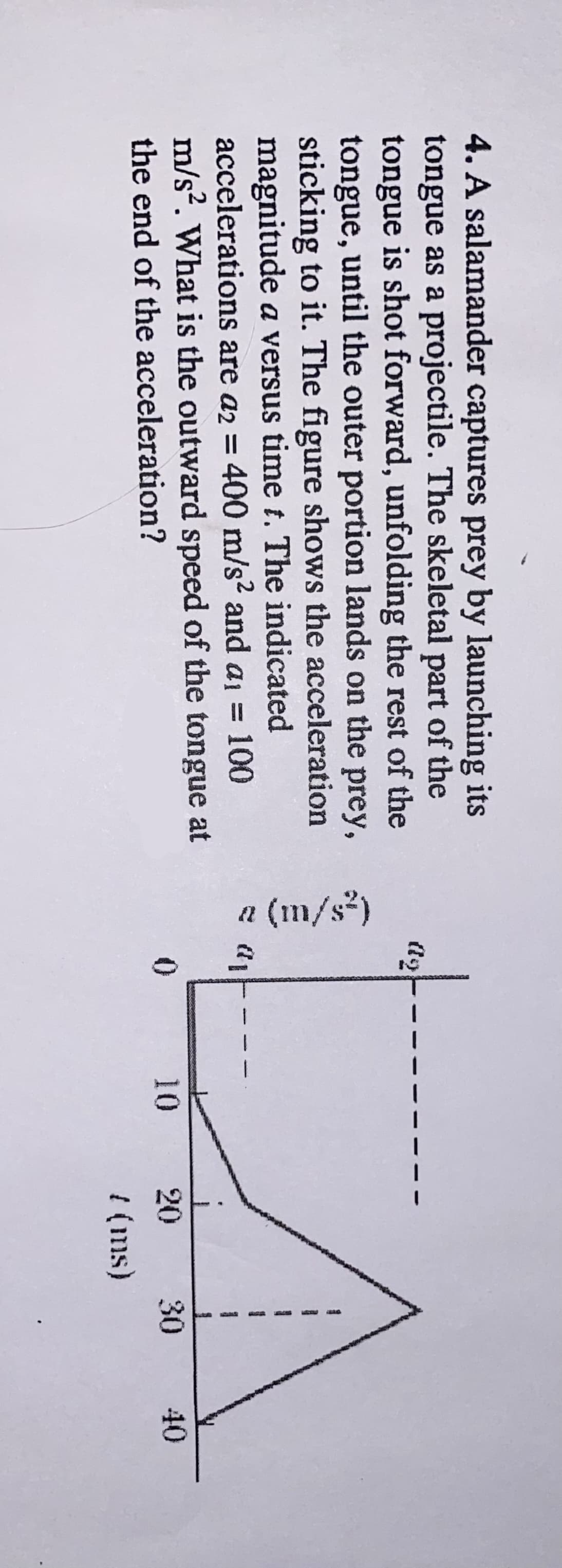a (m/s2) 4. A salamander captures prey by launching its tongue as a projectile. The skeletal part of the tongue is shot forward, unfolding the rest of the tongue, until the outer portion lands on the prey, sticking to it. The figure shows the acceleration magnitude a versus time t. The indicated accelerations are a2 = 400 m/s2 and a1 = 100 m/s?. What is the outward speed of the tongue at the end of the acceleration? 10 20 30 40 { (ms)
a (m/s2) 4. A salamander captures prey by launching its tongue as a projectile. The skeletal part of the tongue is shot forward, unfolding the rest of the tongue, until the outer portion lands on the prey, sticking to it. The figure shows the acceleration magnitude a versus time t. The indicated accelerations are a2 = 400 m/s2 and a1 = 100 m/s?. What is the outward speed of the tongue at the end of the acceleration? 10 20 30 40 { (ms)
Physics for Scientists and Engineers, Technology Update (No access codes included)
9th Edition
ISBN:9781305116399
Author:Raymond A. Serway, John W. Jewett
Publisher:Raymond A. Serway, John W. Jewett
Chapter4: Motion In Two Dimensions
Section: Chapter Questions
Problem 4.1OQ: Figure OQ4.1 shows a bird's-eye view of a car going around a highway curve. As the car moves from...
Related questions
Concept explainers
Topic Video
Question
How do I solve this properly in a step by step solution?

Transcribed Image Text:(m/s²)
4. A salamander captures prey by launching its
tongue as a projectile. The skeletal part of the
tongue is shot forward, unfolding the rest of the
tongue, until the outer portion lands on the prey,
sticking to it. The figure shows the acceleration
magnitude a versus time t. The indicated
accelerations are a2 = 400 m/s2 and a1 = 100
m/s?. What is the outward speed of the tongue at
%3D
%3D
the end of the acceleration?
10
20 30
40
{ (ms)
Expert Solution
This question has been solved!
Explore an expertly crafted, step-by-step solution for a thorough understanding of key concepts.
This is a popular solution!
Trending now
This is a popular solution!
Step by step
Solved in 2 steps with 1 images

Knowledge Booster
Learn more about
Need a deep-dive on the concept behind this application? Look no further. Learn more about this topic, physics and related others by exploring similar questions and additional content below.Recommended textbooks for you

Physics for Scientists and Engineers, Technology …
Physics
ISBN:
9781305116399
Author:
Raymond A. Serway, John W. Jewett
Publisher:
Cengage Learning

College Physics
Physics
ISBN:
9781305952300
Author:
Raymond A. Serway, Chris Vuille
Publisher:
Cengage Learning

Glencoe Physics: Principles and Problems, Student…
Physics
ISBN:
9780078807213
Author:
Paul W. Zitzewitz
Publisher:
Glencoe/McGraw-Hill

Physics for Scientists and Engineers, Technology …
Physics
ISBN:
9781305116399
Author:
Raymond A. Serway, John W. Jewett
Publisher:
Cengage Learning

College Physics
Physics
ISBN:
9781305952300
Author:
Raymond A. Serway, Chris Vuille
Publisher:
Cengage Learning

Glencoe Physics: Principles and Problems, Student…
Physics
ISBN:
9780078807213
Author:
Paul W. Zitzewitz
Publisher:
Glencoe/McGraw-Hill